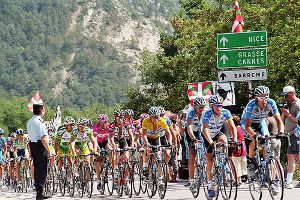The Tour de France
 The Tour de France is considered the biggest event in the worldwide cycling calendar. It’s the bike race that everyone’s heard of, whether you’re a cycling fan or not. And if you’re traveling in France in July, your chances of crossing paths with this famous race are pretty high, so even if you’re not a sports fan and you’ve never heard of any cyclist other than Lance Armstrong, it’s a good idea to familiarize yourself with the basics so you can either be a well-informed spectator – or do your best to avoid the race altogether!
The Tour de France is considered the biggest event in the worldwide cycling calendar. It’s the bike race that everyone’s heard of, whether you’re a cycling fan or not. And if you’re traveling in France in July, your chances of crossing paths with this famous race are pretty high, so even if you’re not a sports fan and you’ve never heard of any cyclist other than Lance Armstrong, it’s a good idea to familiarize yourself with the basics so you can either be a well-informed spectator – or do your best to avoid the race altogether!
The Tour de France is a roughly three-week bicycle race which usually covers more than 3,500km (or 2,200 miles) in total. The overall winner of the race is the cyclist who has ridden the whole route in the least accumulated time. But each day there is a winner of that individual stage – so even though many people will chase the Tour de France around the country to follow all the action, you can pop in and see just a stage or two and still get the satisfaction of catching a bit of the excitement.
Tour de France History
The first Tour de France was held in 1903 as s a publicity event for the sponsoring newspaper, L’Auto. The early Tours de France were grueling affairs, with some individual stages running at 400km or more and many riders finishing in the middle of the night. There were no support crews following in team cars as there are today, many of the mountain pass roads weren’t even paved, and riders were required to carry their own tools and fix their own bikes if they broke down! But somehow, the Tour de France caught on.
The Tour de France has been run nearly every year since 1903, only taking time out during the two World Wars, and it has become the most prestigious race in the sport. Every cyclist dreams of participating in the Tour de France, and either winning a stage or the overall race. It’s also one of the biggest spectator sporting events in the world, once you combine all the people who stand alongside the roads throughout the three-week race. People come from all over the world to watch one or several stages, and many of them camp out along the route in order to secure the best possible spot to view the race on the most important days.
Tour de France Route
While there are some things about the Tour de France route that are predictable, the exact route changes every year. The final stage has included several back-and-forth circuits of the Avenue des Champs-Élysées in Paris since 1975, and it’s one of only a few times each year when the famous avenue is closed to traffic. But the Tour begins in a different city each year, and can even include visits to neighboring countries.
Aside from the Paris finish, the other predictable thing about the Tour’s route is that it switches every other year from a clockwise to counter-clockwise direction around France. It’s not precisely one or the other, but this determines which mountain range the riders face first – the French Alps or the Pyrenées.
The Tour route is announced with great fanfare each fall (usually in October or November) for the following year, and cities that want to be considered for each stage’s start or finish line lobby for the honor – much like the cities wanting to host the Olympics. Most towns through which the Tour de France passes will make a huge deal of it, decorating the streets and sometimes erecting big welcome banners. From a spectator’s perspective, the Tour de France is a big rolling party through the country.
More Tour de France Information
For more information about the Tour de France, be sure to check the WhyGo France posts linked below. You can also check out the official Tour de France website here.